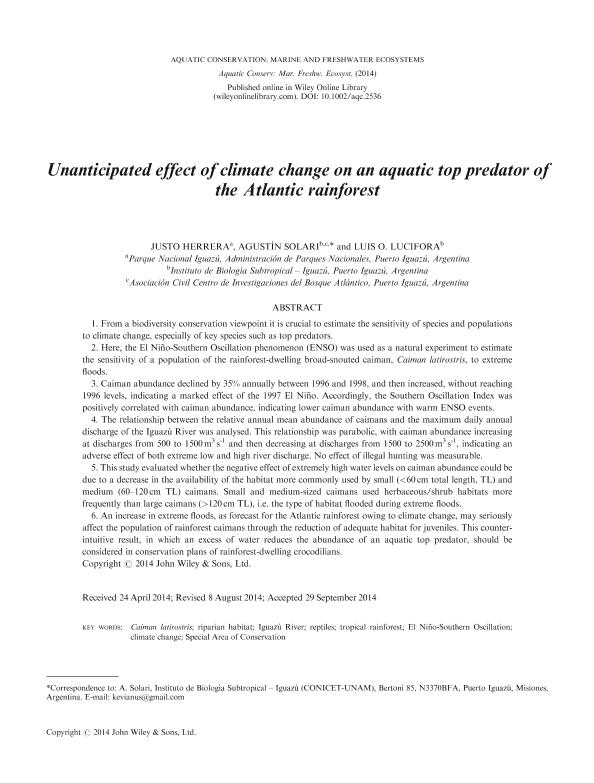Mostrar el registro sencillo del ítem
dc.contributor.author
Herrera, Justo

dc.contributor.author
Solari, Agustín

dc.contributor.author
Lucifora, Luis Omar

dc.date.available
2017-05-09T20:59:50Z
dc.date.issued
2014-12-01
dc.identifier.citation
Herrera, Justo; Solari, Agustín; Lucifora, Luis Omar; Unanticipated effect of climate change on an aquatic top predator of the Atlantic rainforest; John Wiley & Sons Ltd; Aquatic Conservation: Marine And Freshwater Ecosystems; 25; 6; 1-12-2014; 817–828
dc.identifier.issn
1052-7613
dc.identifier.uri
http://hdl.handle.net/11336/16187
dc.description.abstract
1. From a biodiversity conservation viewpoint it is crucial to estimate the sensitivity of species and populations to climate change, especially of key species such as top predators.
2. Here, the El Niño-Southern Oscillation phenomenon (ENSO) was used as a natural experiment to estimate the sensitivity of a population of the rainforest-dwelling broad-snouted caiman, Caiman latirostris, to extreme floods.
3. Caiman abundance declined by 35% annually between 1996 and 1998, and then increased, without reaching 1996 levels, indicating a marked effect of the 1997 El Niño. Accordingly, the Southern Oscillation Index was positively correlated with caiman abundance, indicating lower caiman abundance with warm ENSO events.
4. The relationship between the relative annual mean abundance of caimans and the maximum daily annual discharge of the Iguazú River was analysed. This relationship was parabolic, with caiman abundance increasing at discharges from 500 to 1500 m3 s-1 and then decreasing at discharges from 1500 to 2500 m3 s-1, indicating an adverse effect of both extreme low and high river discharge. No effect of illegal hunting was measurable.
5. This study evaluated whether the negative effect of extremely high water levels on caiman abundance could be due to a decrease in the availability of the habitat more commonly used by small (<60 cm total length, TL) and medium (60–120 cm TL) caimans. Small and medium-sized caimans used herbaceous/shrub habitats more frequently than large caimans (>120 cm TL), i.e. the type of habitat flooded during extreme floods.
6. An increase in extreme floods, as forecast for the Atlantic rainforest owing to climate change, may seriously affect the population of rainforest caimans through the reduction of adequate habitat for juveniles. This counter-intuitive result, in which an excess of water reduces the abundance of an aquatic top predator, should be considered in conservation plans of rainforest-dwelling crocodilians.
dc.format
application/pdf
dc.language.iso
eng
dc.publisher
John Wiley & Sons Ltd

dc.rights
info:eu-repo/semantics/openAccess
dc.rights.uri
https://creativecommons.org/licenses/by-nc-sa/2.5/ar/
dc.subject
Caiman Latirostris
dc.subject
Riparian Habitat
dc.subject
Iguazú River
dc.subject
Reptiles
dc.subject
Tropical Rainforest
dc.subject
El Niño-Southern Oscillation
dc.subject
Climate Change
dc.subject
Special Area of Conservation
dc.subject.classification
Conservación de la Biodiversidad

dc.subject.classification
Ciencias Biológicas

dc.subject.classification
CIENCIAS NATURALES Y EXACTAS

dc.title
Unanticipated effect of climate change on an aquatic top predator of the Atlantic rainforest
dc.type
info:eu-repo/semantics/article
dc.type
info:ar-repo/semantics/artículo
dc.type
info:eu-repo/semantics/publishedVersion
dc.date.updated
2017-02-06T14:25:28Z
dc.identifier.eissn
1099-0755
dc.journal.volume
25
dc.journal.number
6
dc.journal.pagination
817–828
dc.journal.pais
Reino Unido

dc.journal.ciudad
Londres
dc.description.fil
Fil: Herrera, Justo. Administracion de Parques Nacionales. Parque Nacional "iguazu"; Argentina
dc.description.fil
Fil: Solari, Agustín. Consejo Nacional de Investigaciones Científicas y Técnicas. Centro Científico Tecnológico Conicet - Nordeste. Instituto de Biología Subtropical. Instituto de Biología Subtropical - Nodo Puerto Iguazu | Universidad Nacional de Misiones. Instituto de Biología Subtropical. Instituto de Biología Subtropical - Nodo Puerto Iguazu; Argentina. Asociación Civil Centro de Investigaciones del Bosque Atlántico; Argentina
dc.description.fil
Fil: Lucifora, Luis Omar. Consejo Nacional de Investigaciones Científicas y Técnicas. Centro Científico Tecnológico Conicet - Nordeste. Instituto de Biología Subtropical. Instituto de Biología Subtropical - Nodo Puerto Iguazu | Universidad Nacional de Misiones. Instituto de Biología Subtropical. Instituto de Biología Subtropical - Nodo Puerto Iguazu; Argentina
dc.journal.title
Aquatic Conservation: Marine And Freshwater Ecosystems

dc.relation.alternativeid
info:eu-repo/semantics/altIdentifier/doi/http://dx.doi.org/10.1002/aqc.2536
dc.relation.alternativeid
info:eu-repo/semantics/altIdentifier/url/http://onlinelibrary.wiley.com/doi/10.1002/aqc.2536/abstract
Archivos asociados
